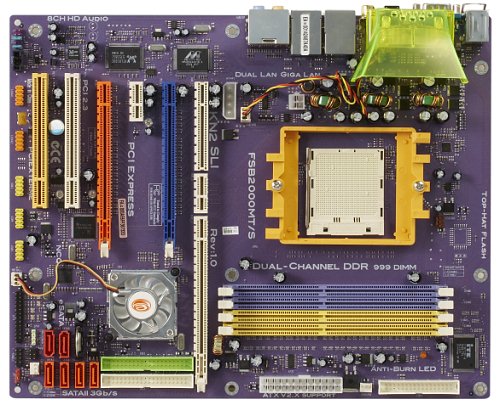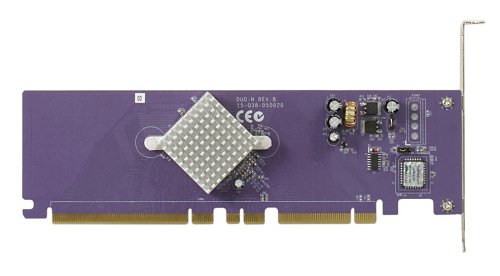 |
||
|
||
| ||
SLI X16 DIY!
Frankly speaking, the new ECS product surprised our seasoned staff in the platform department of our web site so much that some of them expressed quite radical opinions — not to test this motherboard at all. You can see the troublemaker well on the photo — the proprietary slot, which is nearly as long as the board itself. An S.D.G.E card to be installed there (it's included into the bundle and is not sold separately; the card is not optional, as the motherboard does not start up without it) provides full-speed functionality of two PCI Express x16 slots. Right after the announcement of this product we assumed that ECS decided to cut down expenses and adapted a motherboard with a cheap nForce4-series bridge (probably nForce4 Ultra) to support two full-speed PCIEx16 slots instead of designing a "normal" model, having soldered the sterling nForce4 SLI X16 chipset. We assumed that the Duo-N card also houses a cheap nForce4-series bridge, which will support the second graphics slot. That is a customer will be offered an every-little-helps kit, which is only formally compatible with nForce4 SLI X16, but cheaper and problematic in assemblage.  Imagine our surprise when the motherboard was delivered to our lab and we found out that a heatsink on the expansion card covers the nForce SPP 100 chip and that the motherboard is equipped with nForce4 SLI, that is the nForce4 SLI X16 chipset in the true sense of this word! For an obvious reason, northbridge in chipsets for AMD64 is "tied" to a motherboard with fewer junctions than in case of the Intel platform. Very convenient Hyper-Transport bus, connecting in this case not only a northbridge and a processor, but also both chipset bridges, can do a lot of tricks, but we have never seen such "disregard" of the northbridge before! Last year ECS proved its skills to design all-purpose motherboards supporting various CPU types (using SIMA cards). But bringing out part of a chipset into a separate expansion card seems necessary only to support and demonstrate a creative potential of the R&D department. We can see no other reasons for such a violation of motherboard building canons — perhaps the company was planning to launch other models of such expansion cards, but what else can you add to nForce4 SLI X16 functionality?!  However, if we skip the aesthetic aspect of this issue (the absolute majority of users have motherboards hidden inside PC cases), this Duo-N card poses no serious arrangement problems. In fact, motherboard elements are shifted from the CPU socket edge, so there is room only for five regular expansion slots. Two of them are PCIEx16 slots, so we get only 2 x PCI (+1 PCIEx1), one of which will most likely be blocked by a cooler of the second video card. In other respects everything is OK: connectors for storage devices, fans, and brackets with additional ports are located along motherboard edges and are easily accessible when the KN2 SLI Extreme is installed into a PC case. The same concerns the only clear CMOS jumper. ECS engineers didn't waste time on inventing an original cooling system for the chipset (unlike solutions with heat pipes, used in competing motherboards on nForce4 SLI X16): a cooler on the hot southbridge and a heatsink on the cold northbridge. The aluminum heatsink on the southbridge is almost finless, but it's equipped with a fast, audibly noisy fan (that's in the very beginning of its service life, these fans tend to start howling after some time). At the same time, northbridge on the expansion card is equipped with just a small pin-fin heatsink, placed so that it's blown on by the CPU cooler. Such a cooling system copes well with its task at standard operating frequencies and in a "non-extreme" overclocked mode. Besides, we have a brand feature of ECS Extreme motherboards - an additional fan with an air duct near the power converter that blows the air out of a PC case. The 3-phase switching voltage regulator of the processor incorporates 3 field-effect transistors per channel, six 1800 uF capacitors and three 1500 uF ones. The memory voltage regulator is reinforced with L elements and includes several 1500 uF capacitors. Capacitors came from an unknown manufacturer as well as from OST — quite an expected choice for an ECS product. I guess there is no need to say that the PCB layout is unique in all respects, especially as the KN2 SLI Extreme motherboard is the only model in the series of motherboards on nForce4 SLI X16. Nevertheless, the motherboard contains an empty seat for Flash ROM with BIOS. An interesting fact - the retail version of this product lacks this chip (it's on the Duo-N card) — the KN2 SLI Extreme motherboard seems to have a mysterious origin. Motherboard dimensions — 305x245 mm (full-size ATX), nine-screw mount, all corners are firmly fixed.  Let's say a couple of words about the Duo-N card: its dimensions are dictated only by the necessity to lay out all input and output buses, the front side houses nothing but northbridge chips and Flash ROM, the back side is absolutely empty. The SDGE slot looks very interesting: we have already seen a similar slot - Elite Bus (PF88 Hybrid has it for installing SIMA cards). It was a combination of standard PCIEx16 and PCIEx1 slots in a single row. In this case it's PCIEx8, PCIEx1, and PCIEx16 — it again suggests an idea that it's a cunning ECS way to recover rejects. System monitoring (ITE IT8712F-A, according to BIOS Setup):
Onboard ports, sockets, and connectors
Back panel (left to right, blockwise) Click the image to open the rear view of this motherboard
Package Contents
In this case, the set of third-party utilities includes:
Unfortunately, this bundle does not include a proprietary utility for updating BIOS and system drivers, which can also search for the latest versions on the manufacturer's web site. To flash BIOS under Windows, you are recommended to use the standard WinFlash utility from Award. Integrated Controllers
The integrated audio quality was tested in 16bit, 44 kHz using the RightMark
Audio Analyzer 5.5 test application and the Terratec
DMX 6fire sound card:
General performance: Good (Details). Proprietary technologies and peculiarities
Settings
We used BIOS 1.0b dated 19.12.05, the latest available BIOS version at the time of our tests. The mentioned BIOS parameters are available in this version, but the viability of non-standard settings hasn't been tested. The motherboard cannot boast of abundant overclocking options (especially compared to competing models from ASUS and MSI on this chipset). We have no other gripes with it, the motherboard correctly detects memory timings (by SPD), including the 1T/2T setting. PerformanceTestbed configuration:
We compared our model under review with the ASUS A8N32-SLI Deluxe motherboard, as a leader in performance tests (viz. a usual model without performance drops) among nForce4 SLI X16-based motherboards reviewed in our testlab.
Conclusions are obvious: the ECS KN2 SLI Extreme motherboard demonstrates the same performance level as the other models — close to the maximum level for this configuration (processor/memory/video card). ConclusionsDrawing a bottom line, we should say that the decision of ECS engineers to bring one of the chipset bridges into an expansion card is little different from a functional point of view (to be more exact, no different) from the traditional solution, when both chips are installed on a motherboard. We vaguely feared that motherboard performance would drop due to a complicated data path (composite design), but fortunately our fears proved wrong. On the other hand, customers gain nothing from this solution either. Cluttering a PC case with another card is hardly welcome, as it interferes with the common ventilation scheme. Besides, it looks so-so. Considering that this BIOS version does not shine in overclocking options as well as in brand features, we hope that ECS marketing specialists will use the most natural trump card for its promotion — a much more attractive price versus its closest competitors. And of course we expect ECS to carry on with its new trend and launch a motherboard with a processor socket on a separate card in a 5-inch bay (for upgrade convenience?) next year. No less! This model on the manufacturer's web site (Russian mirror) The motherboard is kindly provided by the manufacturer
Write a comment below. No registration needed!
|
Platform · Video · Multimedia · Mobile · Other || About us & Privacy policy · Twitter · Facebook Copyright © Byrds Research & Publishing, Ltd., 1997–2011. All rights reserved. | ||||||||||||||||||||||||||||||||||||||||||||||||||||||||||||||||||||||||||||||||||||||||||||||||||||||||||||||||||